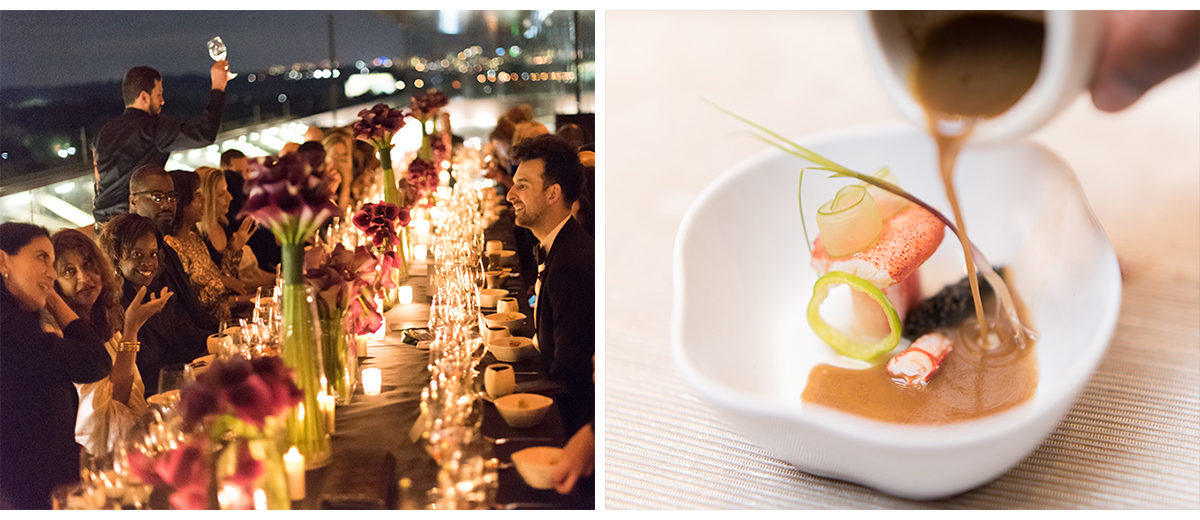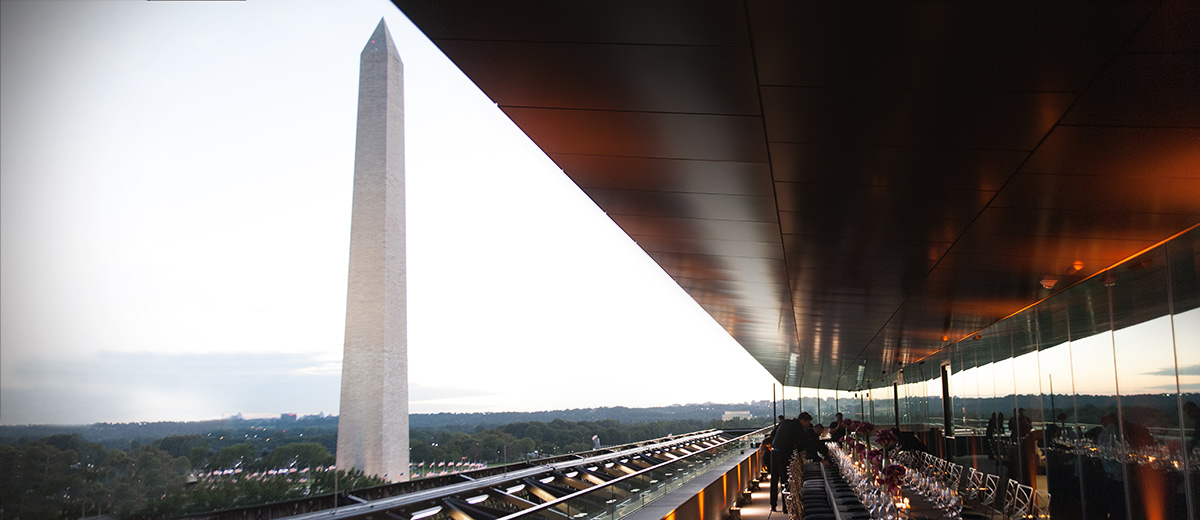African American History, One Cuisine at a Time
by Kelly Magyarics, DWS | photos by Robert Chicoine
The roof terrace’s long rectangular table was set with black linens and vases of fuchsia calla lilies, affording nighttime views of the Washington Monument to the 60 guests in attendance. The long-awaited National Museum of African American History and Culture had just opened to the public a few weeks previously; tonight was a celebration of its Ghanaian-British designer, David Adjaye.
On October 6, 2016, Dom Pérignon hosted a dinner honoring Adjaye, with the Champagne house’s offerings paired with the cuisine of Head Chef Kwame Onwuachi, the former Top Chef contestant whose prix fixe modern American restaurant The Shaw Bijou was set to open in the city’s trendy Shaw neighborhood a few weeks later.
 Left: Guests enjoyed a four-course dinner at the National Museum of African American History & Culture.
Left: Guests enjoyed a four-course dinner at the National Museum of African American History & Culture.
Right: Second Course | Luxe Riff on Gumbo
Onwuachi collaborated for a month with the team at Dom Pérignon to create the four-course menu and gleaned inspiration from different eras and styles of African American cuisine, including Creole, Caribbean and Soul Food. “I tried to break down each dish to its components,” Onwuachi explained. For the first course, silky candied-yam velouté was elevated with black truffle, toasted pepitas added crunch and parmesan foam mimicked marshmallows placed atop sweet potato casserole. “[Ingredients] were reimagined and incorporated into the menu—telling not only the stories of Kwame’s life, but also the important history of dishes, ingredients and preparations of food that were brought to the U.S. or cultivated by black Americans throughout the history of the United States,” notes Dom Pérignon Director of Communications Rachael Ruddick.
 Left: Dom Pérignon USA Brand Director Richard Beaumont
Left: Dom Pérignon USA Brand Director Richard Beaumont
Center: Chef Kwame Onwuachi paired four courses with Dom Pérignon Champagne at the special dinner honoring the museum’s Ghanaian-British designer, David Adjaye.
Right: Third Course | Caribbean-Influenced Wagyu Mojo
The second course, a luxe riff on gumbo, took the Creole roux-based staple apart and put it back together again. Bowls with chilled new-shell lobster, king crab and osetra caviar were brought to the table along with stoneware jugs of warm crustacean consommé which guests poured themselves. Onwuachi liked the temperature contrast and the “pop” of caviar in your mouth, while Ruddick pointed out that the pairing of the 2004 Dom Pérignon Rosé’s “fresh, intense red fruit on the nose [and] signature minerality and spice” played off the briny shellfish and rich broth. A Caribbean-influenced Wagyu mojo paired beef short rib with red bean sofritos and mojo aigre douce (a sweet and sour sauce), along with a hybrid habanero that removes the heat while retaining the pepper’s bright and fresh flavor. “You don’t really tend to pair short rib with Champagne, but it washes away the fattiness of the Wagyu,” admits Onwuachi. “You can pair Champagne with anything, really.” That night, it partnered with the 1998 P2 Vintage, which boasted notes of honeysuckle, caramel, orange fruits and a smoky finish.
 Left: Dom Pérignon paired a different Champagne with each of the four courses
Left: Dom Pérignon paired a different Champagne with each of the four courses
Right: Fourth Course | Beet Butter Cake
Capping off the evening was an earthy beet butter cake—the precursor to modern red velvet cake, Onwuachi pointed out, as the root vegetable has long been used as an intense natural food dye. It was served with cream cheese sabayon, sorrel and a chocolate malt snow reminiscent of freeze-dried ice cream.
Onwuachi had free reign that evening to shape the menu with not only his own choice of ingredients and techniques, but his own personal experiences, all in a much-anticipated space that means so much to so many people. “For me, the most memorable part of the evening was speaking to the guests and talking them through the experience,” he muses. “Seeing everyone there—the whole experience was a milestone for my career, making my own story and cooking on top of the history of my culture.”
 Chef Kwame Onwuachi (center) is surrounded by the team with whom he worked for the four-course dinner on the terrace of the National Museum of African American History and Culture.
Chef Kwame Onwuachi (center) is surrounded by the team with whom he worked for the four-course dinner on the terrace of the National Museum of African American History and Culture.


